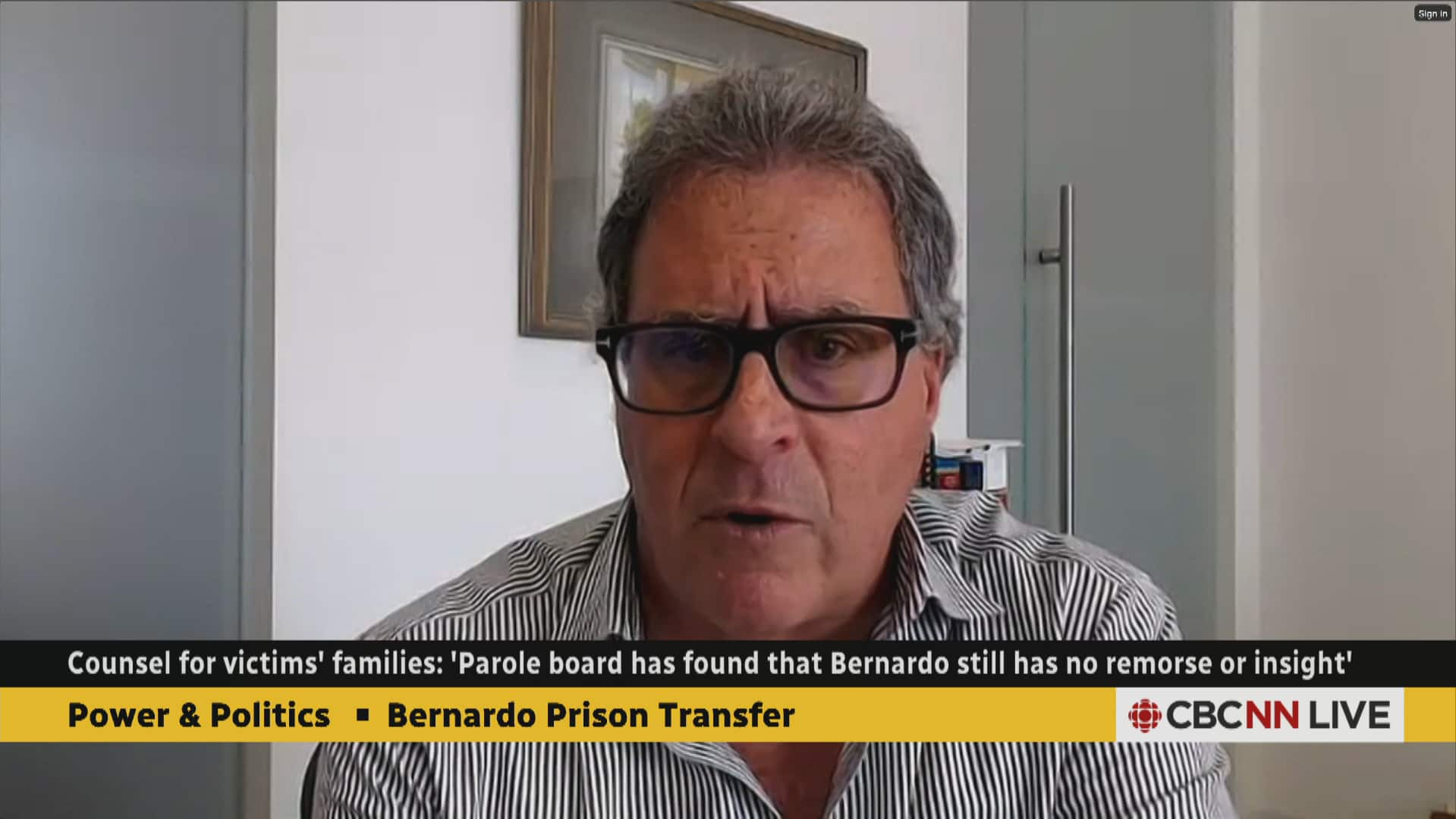A report from the the Correctional Service of Canada offers new details of Paul Bernardo’s life behind bars — and what led to the controversial decision to transfer one of Canada’s most infamous killers to a medium security prison.
Anne Kelly, head of the Correctional Service of Canada (CSC), released a review committee’s report this week detailing the prison transfer that sparked widespread public outrage.
The review concluded that CSC followed the rules in transferring Bernardo but said more could have been done for the victims’ families, who felt shocked and betrayed by the move. A lawyer for the families continues to call for Bernardo to be sent back to maximum security.
Bernardo, a designated dangerous offender, is serving a life sentence for kidnapping, torturing and killing Kristen French and Leslie Mahaffy in the early 1990s. He was also found guilty of the manslaughter and sexual assault of his 15-year-old sister-in-law Tammy Homolka.

Canada’s privacy commissioner weighed the public’s interest against Bernardo’s privacy rights and, in a rare move, allowed the release of new personal information about his case.
Here’s what the 85-page report reveals about Bernardo’s 28 years in prison.
Bernardo’s security level was assessed 14 times between 1999 and 2022. One of the tools the corrections system uses to determine if an inmate is in the right prison is the “security reclassification scale.”
Since 1999, that scale produced a score that recommended Bernardo be classified as medium security. That recommendation was overridden 13 times over 23 years, keeping Bernardo in a maximum security prison.
The reason given for maintaining Bernardo at maximum security was his own personal safety. Bernardo needed “significant security measures and restrictions on movement,” the review committee’s report said.
WATCH | Outrage over Paul Bernardo’s transfer to medium security prison:
Canada’s prison service is now reviewing its decision to move notorious serial killer and rapist Paul Bernardo from a maximum-security prison to a medium security facility. The transfer has sparked outrage across Canada’s political landscape. Bernardo is serving a life sentence for the murders of Kristen French and Leslie Mahaffy in the early 1990s.
The report said Bernardo was considered an “inmate in danger” when he was first sent to the Kingston Penitentiary in 1995 and he was involuntarily segregated for 18 years until the prison closed.
A heavily redacted annex of Bernardo’s institutional chronology suggests he was the “victim” in a dozen incidents between 1995-2019.
He was classified in prison as a “conformist.” That means he’s “been the victim of attempted and actual assaults but has not engaged in violence against other offenders or staff,” the report said.
Unauthorized items or contraband have been found in Bernardo’s cells three times over the decades.
In 1995, a razor blade was found in his cell while he was in solitary confinement in the Kingston Penitentiary. Charges were laid and later withdrawn after a weapon was found in his cell in 2018 at Millhaven Institution.
Bernardo instigated 9 incidents in prison
Records show Bernardo was the instigator in nine incidents over the past two decades behind bars. He faced nine institutional charges and was found guilty four times in 1999 for disobeying the rules.

The incidents documented include a minor disturbance that caused inmates to throw trays, making threats in 1998 and involvement in a confrontation between two offenders in 2006.
When Bernardo applied for a prison transfer last year, his case management team said that “he has remained incident-free for the majority of his sentence, with the last noted concerns occurring four years ago in December 2018, when he was belligerent with staff and refused to return to his cell,” the review committee report said.
Psychologist concluded problematic behaviours persist
The results of Bernardo’s score on the “Severe Sexual Sadism Scale” — a screening device used by prison officials — are redacted from the review committee’s report.
The report does say a psychologist concluded that Bernardo participated in “offence-related programming but continues to exhibit offence-related problematic attitudes and behaviours … He continues to present with needs in the most relevant domains.”

The report cites a series of tests conducted in 2023 that concluded Bernardo has “several responsivity issues” and warned improvements remained “intermittent.”
The report said Bernardo showed a low potential for reintegration outside the prison system and may not fully accept responsibility for his actions. Other tests found he was engaged in his correctional plan and his motivation was rated as “medium.”
A 2014 spousal risk assessment found Bernardo was identified as having a “high probability of risk for violence towards a partner and a moderate risk of violence toward others.”
The key change that led to Bernardo being transferred to a medium-security prison happened a year ago, the review committee found. On July 20, 2022, Bernardo “fully integrated” on the prison range with a larger group of offenders, the report said.
The head of the Correctional Service of Canada, which runs the prison system, says the service followed the rules around the prison transfer of Paul Bernardo. The commissioner of the agency said Bernardo met the criteria for the transfer. However, a review committee said more could have been done to notify his victims’ families.
He integrated with two groups of 28 offenders and 10 offenders, the report said. That means that, for the first time in his incarceration, he went to the yard with everyone from his range, rather than alone.
The committee’s report said that no security concerns were noted and when there were assaults on the range, Bernardo was not involved.
Bernardo’s request for transfer rejected last year
Bernardo asked in 2022 to be transferred to the nearby medium-security Bath Institution in Ontario. That request was rejected.
Bernardo was told the prison wasn’t suitable because it didn’t have locking doors, common washrooms were always accessible to offenders and there were a high number of violent inmates, the review committee found.
Bernardo also was told he could not be transferred to any other prison in Ontario because of how notorious his case is in the province.
He then set his sights on Quebec, putting in a request to be moved to La Macaza Institution. The review committee’s report said that prison was deemed “compatible” because it had in the past “safely” held high-profile offenders serving time for sexual offences.
Guards got no warning of Bernardo’s transfer
Victims’ families were given a “heads up” the morning of Bernardo’s prison transfer on May 29. The transfer was kept on a “need to know” basis, the review committee’s report said.
Tim Danson, counsel for the French and Mahaffy families, is calling for changes to the law that allowed serial killer Paul Bernardo to be transferred to a medium security prison.
“There was a heightened need to be vigilant” because Bernardo’s case is so notorious, the review committee report said.
To ensure the the “safety and security of the escort and the offender,” staff transporting Bernardo were not told the identity of the offender until the morning of the transfer, the report said. There were also no stops on the way to Quebec during the 4-hour-plus drive.
Risk of escape the same at medium-security prison
Bernardo’s prison transfer “does not provide Bernardo with any increased access to the community,” the review committee’s report said.
Just like a maximum-security prison, La Macaza is surrounded by a high barbed wire fence and inmates’ movements are monitored by armed guards, the report said. Kelly said that inmates at La Macaza have the same access to visitors, education and programs as inmates in maximum security.

The food there isn’t any better either, Kelly said. “The menu is the same whether you’re at maximum, medium or minimum” she said.
Experts say Bernardo could spend more time outside of his cell at La Macaza and receive specialized programming for sexual offenders.
Victims’ rights could improve after Bernardo’s transfer
The review committee’s found there was nothing stopping the Correctional Service of Canada from sharing more information with the victims’ families. It recommended striking a working committee to improve practices on engaging with victims and their loved ones.
The review committee concluded that it hopes the Correctional Service of Canada reflects on “victims considerations” including “courtesy, compassion and respect.”‘
A new ministerial order released Thursday is also expected to improve the chances of victims’ families being warned in advance of a potential transfer so that they can update their victim impact statements. It’s a move the federal ombudsman for victims of crime has been calling for since the office opened about 15 years ago.
Read the full report here:
















Leave a comment